| ||||||||||||||||||
| ||||||||||||||||||
NOTE: Meteor photos moved to the METEORS & METEOR SHOWERS page!!
|
|
|
|
These images were taken at about 5:08 UTC, 110 minutes after launch, a little over half an hour after the rover separated from the 3rd stage, when the pair were about 13,000km (8,000 miles) away from me. As time passed I could see the pair were moving farther apart due to the separation manoeuver.
The static image is a shifted stack of six 0.5 second exposures (so the cumulative exposure time is 3 seconds), taken with my SBIG ST-7XME camera on a Meade 8" F/10 LX200 telescope with a 0.63x telecompressor. Image scale is approximately 1.3 arcseconds per pixel (4 arcsec/pixel in the movie), with gamma brightness scaling. North is up and East is left.
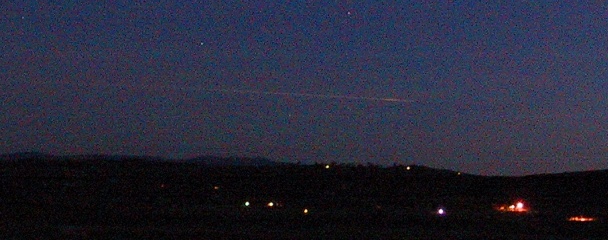
|
|

|
"I set up three cameras: a digital SLR with a wide angle lens, a small digicam, and a video camera. My observing was naked-eye and through the video camera viewfinder.
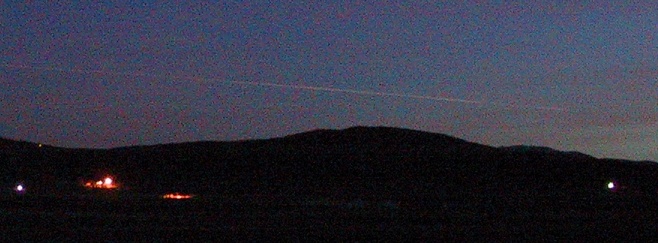
|
"I got back home right at the predicted landing time, and immediately knew something bad had happened when NASA TV was still showing Mission Control instead of the Shuttle swooping onto the runway. It was gut-wrenching.
"Upon reviewing my photos and video I noticed Colmubia leaving a puff of something at 5:54:34am PT followed three seconds later by separation of a large chunk of something, possibly tiles or some other kind of debris. I submitted the video to NASA. I hope it will be of help in the investigation, and I hope that we can return to flight soon and safely."
February 20, 2003 update: An area near Caliente, Nevada is being searched for debris. Read this press release. I believe "Video imagery of Columbia's entry" is referring to me and a couple of other people who got video of this debris event.
March 17, 2003 update: Paul Hill gave an excellent briefing on the status of NASA's analysis of photos and videos of the reentry. Scroll about 2/3 of the way down that page. I saw Flash 1 and Debris 6.

|
| Courtesy CAIB/NASA |
July 11, 2003 update: After a dramatic foam-hits-wing-and-creates-huge-hole test, it was observed that the recreated foam impact caused the wing leading edge panel to crack into chunks up to a square foot in size. The CAIB believes one of these leading edge "RCC" chunks is what is visible as debris my video. However they cannot rule out shuttle "tiles" as a source of the debris.
July 14 2003 update: I received a package from NASA JSC containing a thank-you letter from Paul Hill and a hardcopy of the 186 page Early Sighting Assessment Team's final report (way cool, thanks!). According to the report, the tracking number NASA uses when referring to my video is EOC2-4-0066. A total of five people (including myself) got useful video of the flash/debris I saw. The final conclusion is that Debris 6 separated from the Shuttle at 13:54:34.2 GMT +/-0.5s (causing Flash 1), had a ballistic coefficient of 3.5psf +/-0.5psf, and probably impacted the ground somewhere between Caliente, Nevada and Zion National Park, Utah. Ground searches have not found anything.
January 29, 2005 update: I attended a reunion of other photographers who saw the Columbia reentry. Details here.
July 26, 2005 update: I was present for the return to flight (click link for story), the launch of Space Shuttle Discovery on mission STS-114, a fulfilling closure to the Columbia accident.
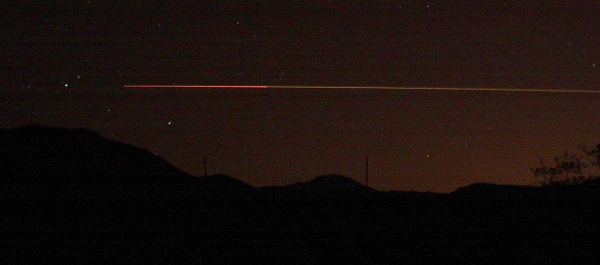
| This (8 second) time exposure is of the Space Shuttle Columbia reentering the atmosphere for a landing at Kennedy Space Center on March 12, 2002, after a successful mission to service the Hubble Space Telescope on mission STS-109. Local time here in San Diego was around 1:10am, about twenty minutes before it landed in Florida. It looked like a very bright orange star streaking across the sky, while leaving a glowing train behind it. The glowing train was visible for several minutes after the shuttle had passed. Click here for NASA's map of the Shuttle's descent path. |
|
Photograph of a sunset behind the Children's Hospital here in San Diego. I took this on the front steps of my house (I have since moved). This actually shows the famous "Green Flash", where the topmost part of the Sun turns green due to refraction. Just seconds before sunset you can see this effect with the naked eye, if conditions are right.
Check out my San Diego Sunsets page for many more beautiful sunset photos. |
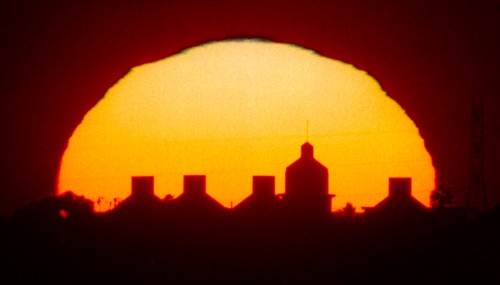
|
| No, this isn't a meteor too, it's a spacecraft! This is a photo I took of the NEAR spacecraft when it made a swing past the Earth on January 23, 1998. What you see is th Sun reflecting off of the solar panels of the spacecraft as it was passing by. This is a ten minute exposure, made with a conventional camera piggybacked on my telescope. The reflection was visible to the naked eye for almost two minutes at my location. At the time of this photo, NEAR was about 10,000 miles away. |
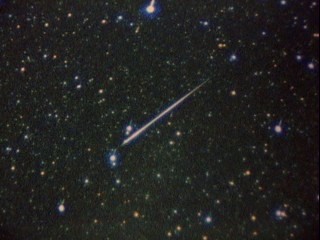
|
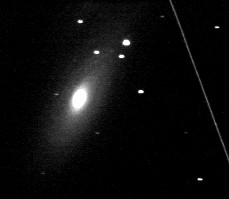
| Only about half of the pictures I take are usable. Sometimes the wind blows and jiggles the telescope, sometimes the scope doesn't track properly, and sometimes images will be ruined by... space junk. Because the telescope is so powerful and my camera is so sensitive, I can see a lot of the stuff in orbit around the Earth. When one of these things streaks by between me and what I'm trying to take a picture of, it leaves a trail. |
| Down here in San Diego, it's extremely rare to see the Aurora Borealis. Only after the most powerful solar storms at the peak of the 11-year solar cycle is there any chance of seeing an aurora. I got lucky on November 6, 2001. |

|
Why don't you head on to my Nebulae, Galaxies, and Clusters page now?
Or, you can go back to my main astronomy page for lots more good images!
Comments? Questions? Click here to send email to me, Fred Bruenjes.
All text and images are © 1995-2002 Manfred Bruenjes - All Rights Reserved. Image inlining is strictly prohibited. Email for permission before using an image or text.